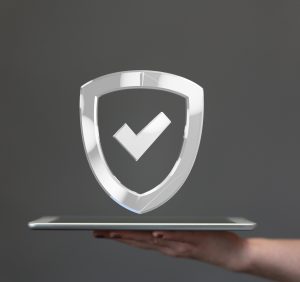 Technology and the internet provide a lot of speed, access, and convenience to our everyday lives. Unfortunately, they are also a virtual playground for a lot of bad actors who are always finding new ways to take advantage of the unwary and unprotected.
Technology and the internet provide a lot of speed, access, and convenience to our everyday lives. Unfortunately, they are also a virtual playground for a lot of bad actors who are always finding new ways to take advantage of the unwary and unprotected.
Hackers and cyber thieves can truly wreak havoc. According to the Harris Poll, the majority (59%) of Americans report having experienced cybercrime. That’s 152 million people who have had their data security compromised!
Leading security company Symantec organizes cybercrime into several categories, including computer viruses and malware, online credit card fraud, identity theft, outright scams, and others. And, in another report, Symantec found that over the course of just one year, 60 million Americans were victims of identity fraud. In dollars and cents, that translates into a consumer loss of $16.8 billion! And, sadly, according to FBI cybercrime statistics, people older than 60 are the most likely to become victims of online cons.
Even though these numbers are staggering, the reality of the situation may be even more dire since the vast majority of cybercrimes go unreported. In many cases, the victims aren’t even aware that their data or accounts have been compromised.
Perhaps the most astounding statistic of all is that, again according to the Harris Poll, 14% of American consumers do absolutely nothing to improve their cyber security. So, even though most Americans are worried about cybercrime, very few take steps to protect their data.
While, it’s easy to understand why so many people fail to protect themselves online, it can be difficult to know which sources to trust and which steps to take. And even if you figure out what you should be doing, the process can seem overwhelming or unduly time consuming.
To help you get started, we’ve compiled a list of some quick and easy things you can do to keep yourself (and your data!) safe from the clutches of cybercriminals.
Do Your Due Diligence
1. Always Be Skeptical
If something seems to be too good to be true, it probably is. When it comes to digital communication—email, text, social media, etc.—and even sometimes phone conversations, it’s always best to question everything. Never rush to take action. Many cons rely on the victim feeling pressured into doing something quickly, without thinking about it too hard. Don’t fall prey to that trap.
2. Confirm Identities
Even before we had deepfake technology, we were constantly dealing with people impersonating other people. And in the digital arena, it can be impossible to tell who you’re really talking to. One simple trick is to always confirm the identity of the person you’re dealing with or the entity sending you an email or text. Instead of clicking on links in the communication, go directly to the supposed source, and navigate to the information that way. For instance, if you receive a text that says it’s from your bank, and you have a new private message; don’t click the link in the text. Instead, go to your bank’s website directly, and navigate to your messages from there.
3. Never Send Private Information
You’ve heard legit businesses and organizations say it over and over again, “We will never ask you for your account, payment, or other information over the phone. Ever.” Believe them. Scam artists will try to convince you that it’s okay to give them information over the phone or via email. Don’t. There are always secure ways to provide necessary personal information.
4. Stay Up-to-date on Security Breaches
Keep an eye on the news for major security breaches at consumer companies. And when you get a notification about a breach that has potentially affected you, pay attention. After you’ve verified the authenticity of the notice, take the recommended steps (usually updating your password) to counteract the issue.
5. Shred Your Documents
Recycling or tossing out receipts, invoices, account statements, and even things like credit card offers can put you at the mercy of identity thieves. While it might seem like overkill, shredding any documents that have personal information (name, address, and certainly your social security number or any financial information) is actually a good idea.
6. Review Account Statements Regularly and Set Up Banking Alerts
A lot of cybercrime goes unnoticed because the criminal activity flies just below the radar. Stay vigilant by reviewing your bank statements carefully for unfamiliar charges, and contact your bank immediately if you see any purchases that you don’t recognize. It can also be helpful to set up banking alerts that will text or email you when any transaction exceeds a certain dollar amount.
Just be warned that such alerts won’t catch every potentially fraudulent transaction. Many cybercriminals know not to make large purchases, and will instead make many small ones that add up over time. And remember that if your credit or debit card is compromised, it’s not just your money that’s at risk, it’s also other personal information and even your identity.
Protect Your Tech
1. Update Your Software
Most of us are guilty of skipping software updates, either because we don’t think we have time or because we’re worried the update will backfire. However, it’s really in your best interest to install updates as soon as they are available.
Hackers look for weaknesses in software, and software developers are always updating their code to “patch” those weaknesses and keep their products safe. The easier way to make sure you’re running the safest version of any program, operating system, or app is to opt for automatic software updates.
2. Avoid Public WiFi
We love free stuff, and free WiFi is no exception. The trouble is that public WiFi is accessible to anyone and everyone, and it puts users in a very vulnerable position. Hackers and other cybercriminals often use public networks to gain access to devices that would otherwise be secure on their own home networks. Side note: If you ever use a public computer (such as in a library), make sure you fully log out of any sites that require passwords.
3. Use a VPN
A VPN or “virtual personal network” uses an encrypted connection to protect your privacy online. While using a VPN doesn’t completely anonymize your online activity, it does do a good job of giving you an extra layer of protection from prying eyes. VPNs also make it harder for advertisers to track you online, and help secure your online communications (such as email). There are many consumer VPN solutions available.
4. Install Antivirus Software
Using antivirus software like Malwarebytes or Norton Antivirus is another way to give your computer a fighting chance against hackers. There are a number of companies that offer consumer products that are easy to install, and which provide an important first line of defense against possible threats.
Improve Your Defenses
1. Practice Good Password Hygiene
We know we should be better about our passwords, but it can be so easy to fall into bad habits like using the same password over and over and over again. Hackers love when we do that. Here are a few quick tips for passwords that won’t let you down:
- Never reuse passwords.
- Never use real words as passwords (password cracking software can guess those easily).
- Never include personal information in your passwords (your birthday or mother’s maiden name, etc).
- Always use passwords that include a variety of characters—upper and lowercase letters, numbers, and special characters.
- When possible, use an auto-generated password such as the ones Google Chrome suggests.
- Don’t store your passwords in plain text on your computer or elsewhere.
- Use a password manager like LastPass, 1Password, or Bitwarden.
2. Opt for Two-factor Authentication
If it’s offered, say yes to two-factor authentication. Two-factor authentication adds an extra step to your log-in process to provide an extra layer of protection. In most cases, the extra step involves the website or app you’re trying to access emailing or texting you a code to input. It’s a simple process that only takes a couple of seconds, and can save you a lot of hassle in the long run.
3. Customize Your Security Settings
It’s never a good idea to rely on the default security settings of a website or app. Most websites and apps have settings or preferences that are specifically related to security. This might include options like two-factor authentication, information about how your data is shared, and other relevant details. It’s worthwhile to check these out, and adjust them to give yourself the highest level of protection you can.
4. Steer Clear of Links and Attachments
Cybercriminals are seeing a lot of success by “phishing” with illegitimate links and attachments in emails and text messages. Part of the problem is that hackers aren’t just sending suspicious looking emails from Nigerian Princes anymore. Today’s phishing scams can look an awful lot like the real deal, so you have to be extra careful not to be taken in.
5. Stop Taking Social Media Quizzes
Those personality quizzes like “Which Disney Princess Are You?” and so forth may seem fun and harmless, but a lot of them are thinly veiled attempts to collect personal information that can later be used to access online accounts. For example, a quiz might ask for things like your mother’s maiden name, the street where you grew up, or the make and model of your first car. These are all common security questions that legitimate organizations use to help verify your identity.
From communicating with our loved ones to shopping at our favorite stores online, the internet provides us with everyday convenience and joy. The key to continued technology health and happiness is to be aware and protect yourself as best you can from cybercrime. Happy hunting!
Related Posts:
Telemarketing Fraud: Tips for Staying Safe
Technology for Seniors – The Good, The Bad and The Ugly
Include Access to Online Accounts in Your Estate Plan: Law Backs You
Does Your Last Will and Testament Include On-line Passwords?
 Connecticut Estate Planning Attorneys Blog
Connecticut Estate Planning Attorneys Blog


